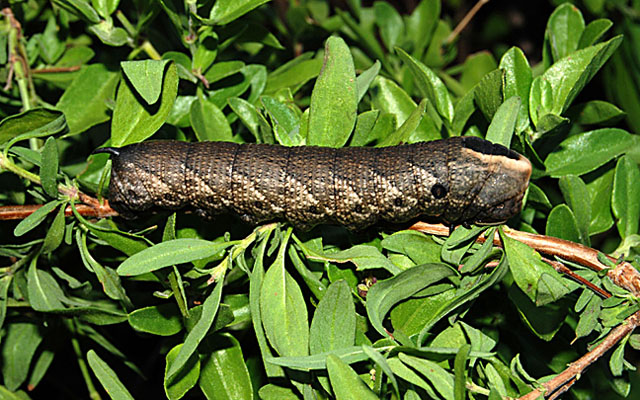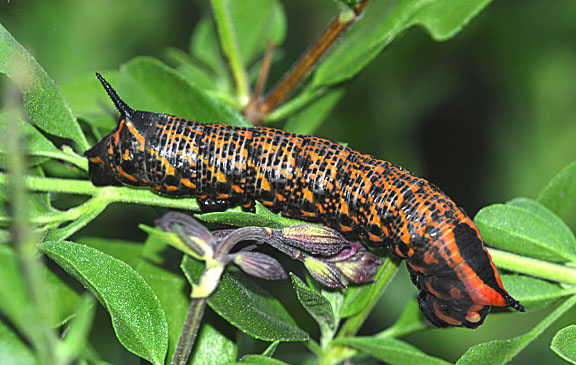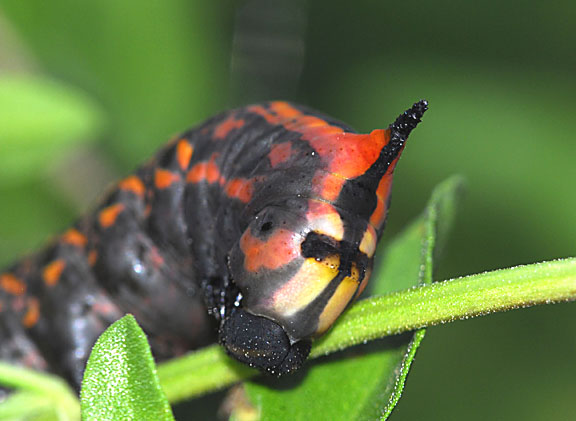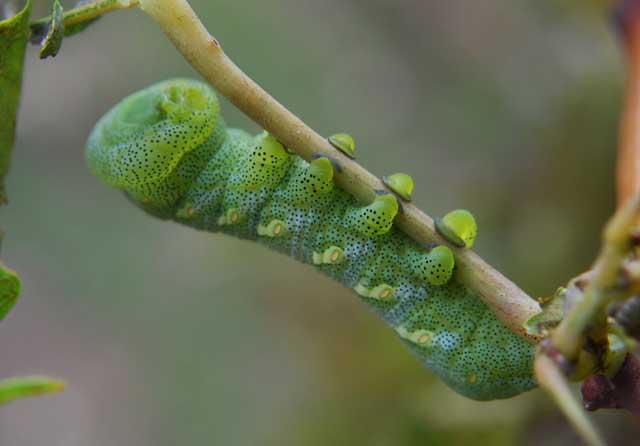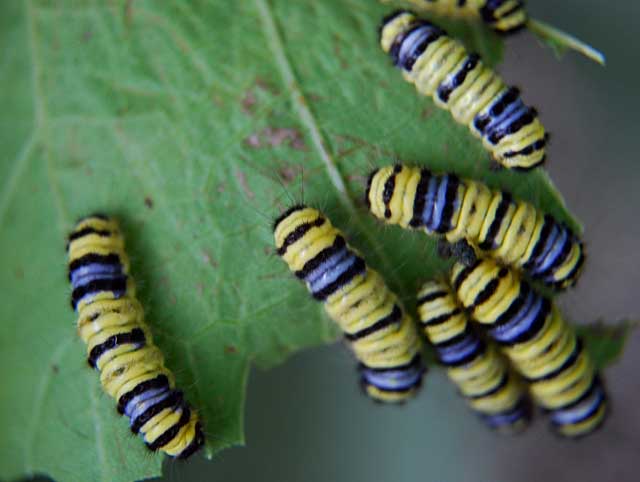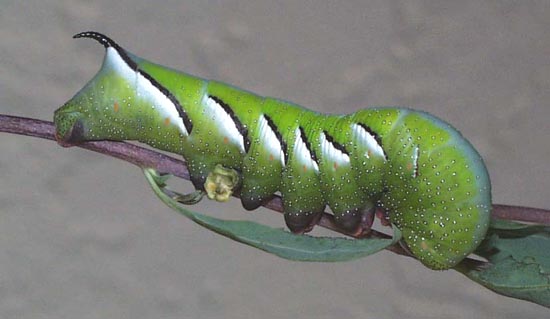Sphinginae subfamily
Sphingini tribe:
 |
Agrius cingulata,
USGS Pink-spotted hawkmoth.
Larvae feed on plants in the Convolvulaceae family, especially
Ipomoea batatas (sweet potato) and in the Solanaceae family,
especially (Datura) (jimsonweed) and related plants in the
Americas. There is also a brown form. Look for very large, dark
spiracular circles.
|
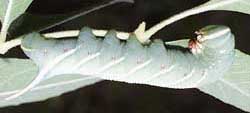 |
Larvae feed on ash (Fraxinus] of the Oleaceae family.
probably rare
|
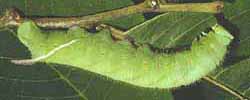
|
Cocytius antaeus,
WO The Giant Sphinx,
stray.
In the last instars, larvae are uniform green with a dark purple
center back line and a very sharp white posterior side slash with
some dark green on both sides of it. very unlikely in larval stage
|
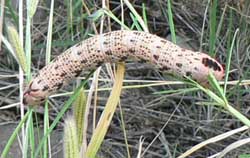 |
Lintneria istar
USGS,
the Istar Sphinx.
Istar Sphinx larvae feed primarily on mints (Salvia).
Larvae can be considerably darker as per the image at top of the page.
I think istar, separatus and smithi are all being
reassigned to the Lintneria genus.
|
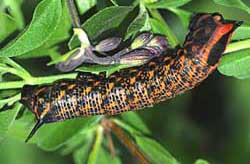 | Salvia greggii has been confirmed as a larval host
by Robert A. Behrstock.
Jim Tuttle, tentative id, writes, "All of the
penultimate instars of both Lintneria (Sphinx) istar and
Lintneria (Sphinx) separatus that I have reared
have been mundane green."
|
Lintneria separatus fourth instar on Salvia greggi, Portal,
September 7, 2010, Barbara Miller.
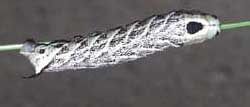
| Larvae feed on mints (Salvia) and are mottled
white and grey-brown with a purplish tint.
|
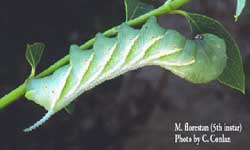 |
Manduca florestan
USGS.
Prominent, extended side slashes determine this species.
Yellow side
slashes often occur on larvae feeding on foliage with yellowish
underside veins. In the penultimate instar, the anterior three
slashes are accentuated. (stray)
|
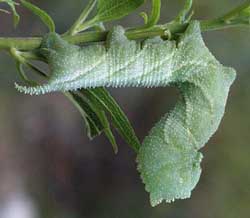 |
Larvae feed on Verbesina gigantea, Lasianthaea fruticosa,
Eupatorium albicaule, Viguiera dentata and
Eupatorium albicaule of the Asteraceae family,
Lantana camara of the Verbenaceae family, and probably on
plants from the families Solanaceae, and Bignoniaceae.
Helianthus annuus and Jacaranda caroba have also been
reported as larval hosts.
|
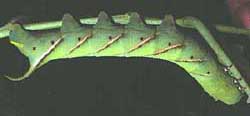 |
Manduca occulta
USGS, Occult sphinx.
Larvae feed on plants in the nightshade
(Solanaceae): Cestrum glanduliferum, Cestrum racemosum, Solanum
accrescens and Solanum hazenii are used in Costa Rica.
|
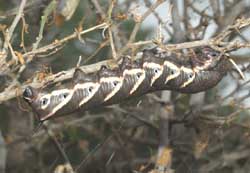
|
The caterpillars are called Tomato Hornworms and each has a black horn at the end of the abdomen.
Larvae feed on potato, tobacco, tomato, and other plants in the
nightshade family (Solanaceae). There is also a very beautiful brown
form to the left.
|
 |
Manduca rustica
USGS, the Rustic Sphinx
The caterpillar has numerous white nodules on top of the thorax and
seven pairs of oblique, blue-gray stripes along the side of the body.
The horn is white at the base and blue-gray at the tip. Many hosts
are utilized.
|
 |
Tobacco Hornworms, equipped with a red-tipped horn at the end of the
abdomen, are true gluttons and feed on tobacco and tomato, and
occasionally potato and pepper crops and other plants in the
nightshade family (Solanaceae).
|
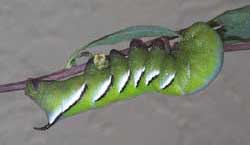 |
Larval hosts are unknown, but larvae probably feed on Lycium
in the nightshade family (Solanaceae).
Note the strong oblique black lines and the black anal horn.
|
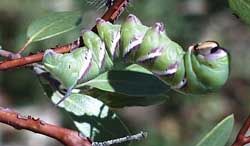 |
Larval hosts are Manzanita and Arctostaphylos
of the Ericaceae family. Look for a blue horn and strong purple
colouration.
|
 |
Sphinx chersis
USGS, the Great Ash Sphinx.
The larvae are pale bluish green. The head has a pair of yellow
lateral bands meeting at the apex.
Larval hosts are ash, lilac, privet, cherry, and quaking aspen.
|
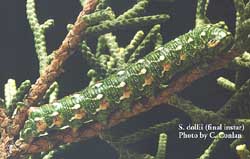 | Larval hosts are Alligator juniper (Juniperus deppeana)
and other juniper species. It is amazing to me how well the larval
spiracular patches and false feet match
the pattern and colour of the juniper bark.
|
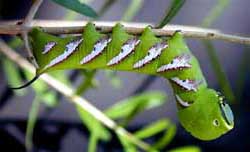 | Larvae feed on New Mexican forestiera
(Forestiera neomexicana), on Forestiera angustifolia
and on little leaf ash (Fraxinus gooddingii) in the Oleaceae
family. There are green and dark forms and all larvae tend to darken
just before pupation.
|
Smerinthini Tribe:
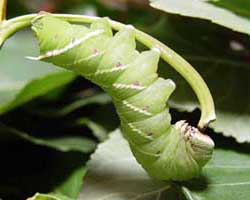 |
Larvae feed on cottonwood and poplar (Populus) and willow
(Salix).
Larvae are very chunky with little to distinguish them
from Pachysphinx modesta.
|
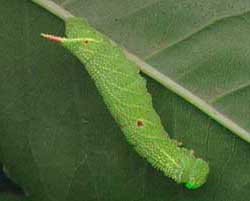 |
Paonias myops
USGS,
the Small-eyed Sphinx
Wild cherry species are the favorites as larval
foodplants, but eggs will also be deposited on birches and other
forest trees. To the left a second/third instar larva rests on pin
cherry.
The "red heart" marking readily identifies this species.
generally more eastern species; possibly |
 |
Smerinthus cerisyi
USGS,
Cerisy's Sphinx;
Cerisyi larvae greatly resemble modesta larvae, both being pale
green, with granular skin, pale lateral diagonal lines, faint red
spiracular circles, and very pale longitudinal lines running from the
head to a more pronounced anal diagonal line.
Larvae have green heads bounded dorsally with a pale yellow
inverted "V".
|
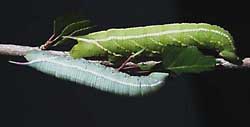 |
Smerinthus saliceti
USGS, the Salicet
Sphinx, flies in valleys and along streamsides from Mexico City north
to west Texas, southern Arizona, and extreme southern California.
There are two colour morphs, one a pale green and one lime green.
Larvae feed on willow (Salix) or poplar (Populus).
|
Macroglossinae subfamily
Dilophonotini tribe:
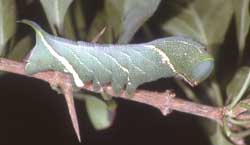 |
Larvae feed on various species of the Rubiaceae (madder) family.
Randia rhagocarpa, Randia monantha, Randia aculeata, Guettarda
macrosperma and Genipa americana are listed as hosts. Probably only further south.
|
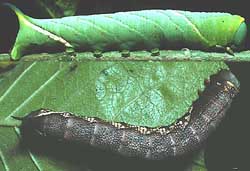 |
Larvae feed on seven year apple, Casasia clusiifolia, common
buttonbush, Cephalanthus occidentalis, and white indigoberry,
Randia mitis. Randia monantha, Randia aculeata,
Albizzia adinocephala and Randia grandifolia, all in the
madder family (Rubiaceae), also serve as hosts. rare |
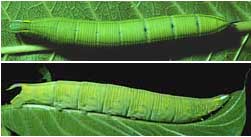 |
Callionima falcifera
WO.
The narrow, flattened head of the larva is clearly visible in the lateral view, left below.
It might be in Cochise County as a stray. |
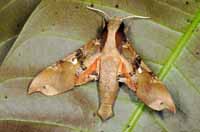 |
may or
may not be present in Cochise County. Sorry, no larval image
available at this time.
|
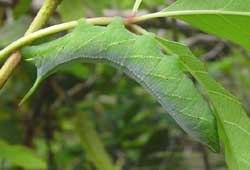 |
Larvae probably feed on
Vitus tiliifolia and other members of the Vitaceae family:
Vitis, Cissus, Ampelopsis. In Florida larvae have been
reported on larvae on Possum Vine
(Cissus sicyoides) and Pepper Vine (Ampelopsis arborea).
|
 |
Larvae feed on papaya (Carica papaya), nettlespurge
(Jatropha), and allamanda (Allamanda).
|
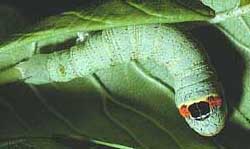 |
Larvae feed on various plants in the dogbane family
(Apocynaceae): Rauvolfia ligustrina, Rauvolfia tetraphylla,
Stemmadenia obovata. There is also a brown form.
|
|
Sorry, no larval image is available at this time.
|
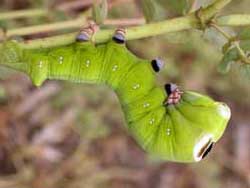 |
Larvae feed on papaya (Carica papaya), Cnidoscolus
angustidens, poinsettia (Euphorbia pulcherrima),
guava (Psidium species) and
saffron plum (Bumelia angustifolia/Bumelia celastrina).
Manilkara bahamensis,
Willow Bustic (Bumelia salicifolia)
and Painted Leaf (Poinsettia heterophylla) are also hosts.
Nice socks! Larvae show considerable variation.
|
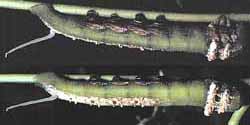 |
Larvae feed on papaya (Carica papaya), Manihot esculenta
and various plants (Macroscepis obovata) in the milkweed
family.
|
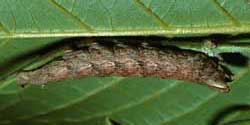 |
Erinnyis obscura, the Obscure Sphinx,
USGS
Larvae feed on Rauvolfia ligustrina, Rauvolfia tetraphylla,
Stemmadenia obovata, Philibertia, Cynanchum, papaya
(Carica papaya), Asclepiadaceae, Blepharodon mucronatum,
White vine (Sarcostemma clausum) and Morrenia odorata.
|
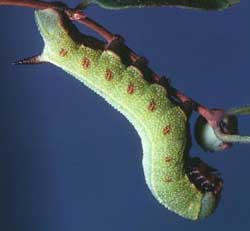 |
Larval host plants include Snowberry (Symphoricarpos),
honeysuckle (Lonicera), Coralberry, viburnums, high bush cranberry and hawthorn (Crataegus).
Horn is black with a slightly lighter base. This western species was formerly classified as
H. diffinis or H. senta. Those species west of the Continental Divide are now classified as
H. thetis.
|
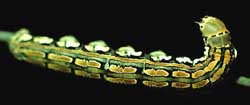 |
Isognathus rimosa, the Rimosus Sphinx,
USGS
Females lay eggs on Frangipani (Plumeria species), including
Plumeria rubra Cuba, and Plumeria alba, Plumeria obtusa
and Plumeria rubra Puerto Rico.
|
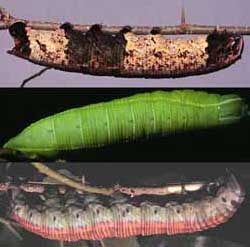 |
Females feed and lay eggs on fig leaves, especially Strangler Fig
(Ficus aurea). Ficus carica, Ficus microcarpa, Ficus
religiosa, Ficus pumila, Ficus gamelleira, Ficus prinoides, Ficus
pumila and Artocarpus integrifolia are also listed as
hosts.
The extreme variability of larvae is shown to the left.
The few images that have been sent to me for identification help
are usually as per the upper image.
|
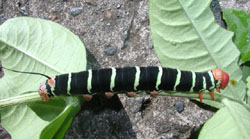 |
Pseudosphinx tetrio, the Tetrio Sphinx,
WO
These caterpillars defoliate the Frangipani tree (Plumeria spp.)
They generally start at the tip of a leaf and work back. The
caterpillar is velvety black with yellow rings and an orange head.
They can get up to six inches long. Larvae also feed on
Allamanda cathartica and probably other members of the
Dogbane family: Apocynaceae.
|
Philampelini tribe:
 |
Larvae feed upon Grape (Vitis), Virginia Creeper
(Parthenocissus quinquefolia) and other vines and ivies
(Ampelopsis).
Larvae occur in both a light (green) form and a darker (tan/brown)
form. Note six "segmented" oblique lines.
|
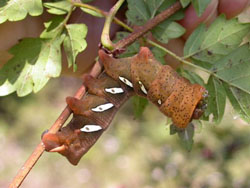 |
In Eumorpha satellitia the white panels are completely
enclosed in black whereas in E. vitis the ends of the black
panels remain open. Also, satellitia has a faint subdorsal
longitudinal stripe that touches the top of the white panels that is
lacking in vitis. I suspect there is also a green form.
|
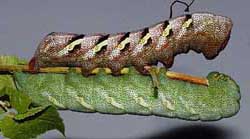 |
Larvae occur in both green and a darker brown form. The head and some
thoracic segments are often retracted when the larva is disturbed.
Larvae feed on grape foliage.
|
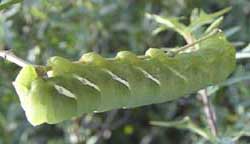 |
Eumorpha vitis
WO,
the Vine Sphinx
Eumorpha vitis vitis larvae feed upon grape foliage (Vitis) and
other vines (Cissus): Cissus pseudosicyoides
and Cissus rhombifolia and Cissus sicycoides.
I suspect there would be a brown form.
Note five, smooth, narrow, oblique white lines.
|
Macroglossini tribe:
 |
Hyles lineata
USGS, the White-lined Sphinx
Larvae are highly varied and feed on a great diversity of plants
including willow weed (Epilobium), four o'clock (Mirabilis),
apple (Malus), evening primrose (Oenothera), elm
(Ulmus), grape (Vitis), tomato (Lycopersicon),
purslane (Portulaca), and Fuschia.
All larvae seem, however, to have the red/black swellings split by
dorso-lateral lines. |
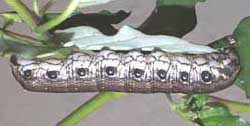 |
The larval hostplants are documented as Boerhaavia species
(at least two--B. coccinea and coulteri have produced
larvae). Boerhaavia is in the plant family Nyctaginaceae. There
is a pale green form.
|
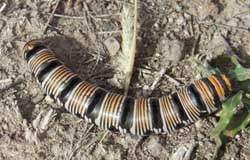 |
Larvae probably feed on (Onagraceae) including evening primrose
(Oenothera), gaura (Gaura), and willow weed
(Epilobium).
|

|
There is a single large eye on the thorax and six white circles down
the side. There are extensive bands of white dots girdling the
abdomen.
|
|
|
